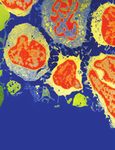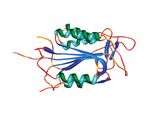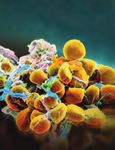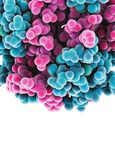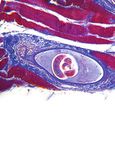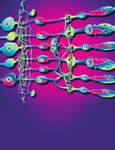Case Report Bevacizumab: A Rare Cause of Nonischemic Cardiomyopathy
←
→
Page content transcription
If your browser does not render page correctly, please read the page content below
Hindawi
Case Reports in Cardiology
Volume 2018, Article ID 1361326, 3 pages
https://doi.org/10.1155/2018/1361326
Case Report
Bevacizumab: A Rare Cause of Nonischemic Cardiomyopathy
Oreoluwa Oladiran and Salik Nazir
Reading Hospital, Tower Health System, West Reading, PA, USA
Correspondence should be addressed to Oreoluwa Oladiran; oreoluwa.oladiran@towerhealth.org
Received 26 April 2018; Accepted 30 July 2018; Published 27 August 2018
Academic Editor: Alfredo E Rodriguez
Copyright © 2018 Oreoluwa Oladiran and Salik Nazir. This is an open access article distributed under the Creative Commons
Attribution License, which permits unrestricted use, distribution, and reproduction in any medium, provided the original work
is properly cited.
Left ventricular dysfunction is a rare side effect of bevacizumab occurring in 2–4% of cases. We report the case of a 68-year-old
woman who presented to the emergency department (ED) with sudden onset of shortness of breath, orthopnea, and paroxysmal
nocturnal dyspnea. She was tachypneic and in respiratory distress. Physical examination revealed jugular venous distention,
diffuse expiratory wheeze, and bipedal edema. She had been started on bevacizumab for the treatment of hereditary
hemorrhagic telangiectasia 1 month prior to presentation. Laboratory tests revealed BNP of 1697 pg/ml with slightly elevated
troponin 0.05 ng/ml. Chest X-ray showed interstitial edema with cardiomegaly, and transthoracic echocardiogram showed
ejection fraction of 30% with global hypokinesia. Left heart catheterization revealed widely patent coronary arteries. Flash
pulmonary edema secondary to acute left ventricular dysfunction in this case was attributed to recent treatment with
bevacizumab after ruling out other possible etiologies. This case highlights the importance of early recognition of this rare but
potentially reversible side effect of bevacizumab to prevent long-term sequelae.
1. Introduction 2. Case Report
Bevacizumab is a humanized monoclonal IgG antibody A 68-year-old woman with past medical history of hyperten-
against vascular endothelial growth factor (VEGF) [1]. VEGF sion, chronic kidney disease stage 3, hyperlipidemia, and
plays an important role in developmental angiogenesis [2]. hereditary hemorrhagic telangiectasia (HHT) presented to
Substantial evidence also implicates VEGF as a mediator of the emergency department with sudden onset of shortness
pathologic angiogenesis—a hallmark feature of hereditary of breath. She also reported chest pain, orthopnea, and par-
hemorrhagic telangiectasia (HHT) [3]. Bevacizumab is oxysmal nocturnal dyspnea. Review of systems was otherwise
approved by the FDA as first-line treatment for a wide range unremarkable. Her HHT was previously managed by regular
of ophthalmologic diseases and malignancies, including glio- blood transfusions and epsilon-aminocaproic acid. Because
blastoma, breast cancer, and metastatic colorectal cancer [4]. of the need for frequent blood transfusion due to persistent
In addition, it is also used as off-label treatment of hereditary epistaxis and gastrointestinal bleeding, she was started on
hemorrhagic telangiectasia-related refractory bleeding [5]. bevacizumab infusion at 15 mg/kg/dose (1150 mg total) by
The main cardiovascular side effects of bevacizumab include her haematologist a month prior to presentation. Initial vital
hypertension, bleeding, and venous and arterial thromboem- signs on presentation revealed respiratory rate of 25/min,
bolism [4]. In about 2–4% of cases, bevacizumab causes oxygen saturation of 65% on ambient air, blood pressure of
reversible cardiomyopathy and left ventricular dysfunction 138/83 mmHg, and pulse rate of 92/min. Physical examina-
even in patients without preexisting cardiac disease [6]. tion revealed respiratory distress with diffuse wheeze, jugular
Prompt recognition and early treatment with guideline- venous distention, and trace pedal edema. Laboratory tests
directed medical therapy along with bevacizumab discontin- revealed markedly elevated brain natriuretic peptide (BNP)
uation are crucial in treating this potentially reversible but of 1697 pg/ml (normal 0–100 pg/ml) with initial troponin of
fatal side effect. 0.05 ng/ml (normal < 0.04 ng/ml). Chest X-ray revealed2 Case Reports in Cardiology
pulmonary vascular congestion and interstitial edema with
mild cardiomegaly. She was immediately placed on noninva-
sive ventilation and started on intravenous furosemide with
quick symptomatic improvement. Transthoracic echocardio-
gram (TTE) showed ejection fraction of 30% and global
hypokinesia (please see Supplementary Materials (available
here)). Of note, TTE done three years prior to index presen-
tation showed ejection fraction of 56%. She does not drink
alcohol, and her thyroid function and sedimentation rate
were normal making other etiologies of acute systolic heart
failure such as thyroid disorder, alcoholic, or inflammatory
cardiomyopathy less likely.
She refused to wear LifeVest and was placed on Widely patent LAD
guideline-directed medical therapy including beta-blocker, system
angiotensin-converting enzyme inhibitor (ACEi), and aldo-
sterone antagonist along with an oral diuretic. The patient
progressively improved and was discharged three days later
and scheduled for follow-up with cardiology for outpatient
right and left heart catheterization. Two weeks later, she
developed another episode of flash pulmonary edema Figure 1
deemed to be due to medication noncompliance. On this
occasion, she underwent left and right heart catheterization
which revealed widely patent coronary vessels (Figure 1), and arterial thromboembolism. Left ventricular dysfunction
elevated pulmonary capillary wedge pressure, and elevated is a rarely reported side effect of bevacizumab with an inci-
left ventricular end-diastolic pressure. She continued to have dence of 1.2%, and this occurs irrespective of the route of
her monthly bevacizumab infusions with her haematologist administration [6].
as this was not thought to be the cause of her cardiomyopathy In this case, the probability of causal relationship of acute
at the time. Three months later, she developed sudden onset left ventricular dysfunction and bevacizumab can be rated as
of chest pain and shortness of breath at home and went into certain based on the World Health Organization and the
ventricular fibrillation-related cardiac arrest. She underwent Uppsala Monitoring Centre (WHO-UMC) algorithm [8].
prolonged cardiopulmonary resuscitation but eventually As with other antineoplastic medications, the pathogene-
had return of spontaneous circulation. She was intubated sis of left ventricular dysfunction is unknown. Several mech-
and admitted to the medical intensive care unit and under- anisms have been proposed including the formation of free
went therapeutic hypothermia. Repeat TTE showed ejection radicals in the myocardium and inflammatory cytokines with
fraction of 34%. She quietly passed away 3 days later. resultant cardiac depression and congestive heart failure [9].
This side effect appears to be dose dependent, and manage-
3. Discussion ment involves dose adjustment. Management also involves
guideline-directed medical therapy with ACEi/ARBs, beta-
Drug-induced cardiotoxicity usually manifests as heart fail- blockers, and aldosterone antagonists together with diuretics.
ure or left ventricular systolic dysfunction. It is commonly Notably patients sick enough to require these medications
caused by chemotherapeutic medications such as anthracy- also have increased risk of toxicity from these medications.
clines and alkylating agents but is becoming increasingly Other forms of cardiomyopathies such as Takotsubo cardio-
reported among biologic drugs such as trastuzumab and myopathy have also been reported following commencement
bevacizumab [7]. of bevacizumab [10].
Bevacizumab is a recombinant humanized monoclonal Serial measurement of left ventricular ejection fraction
IgG1 antibody containing human framework regions and either by transthoracic echocardiogram or by radionuclide
murine complementarity-determining regions. By binding angiocardiography, as done in patients receiving doxorubi-
to vascular endothelial growth factor (VEGF), bevacizumab cin, may be a useful modality in monitoring patients planned
prevents interaction with its receptors (Flt-1 and KDR) on for bevacizumab therapy via any route while the search for
endothelial cell surfaces therefore inhibiting angiogenesis more sensitive and reliable predictors of eventual left ventric-
[4]. Bevacizumab has shown promising activity and improve ular dysfunction continues.
survival of patients with metastatic colon cancer, nonsqua- In conclusion, bevacizumab causes reversible dose-
mous non-small-cell lung carcinoma, and metastatic breast dependent left ventricular dysfunction irrespective of the
cancer. Although not FDA-approved, systemic therapy with route of administration. It is prudent for clinicians to con-
bevacizumab is a recognized treatment for severe forms of sider serial transthoracic echocardiogram and monitoring
hereditary hemorrhagic telangiectasia (HHT) [5] as was the of systolic function to facilitate early detection of this medica-
case in our patient. tion side effect and dose adjustment. This is particularly
Common side effects include bowel perforations, haem- important in patients at high risk of side effects from this
orrhage, delayed wound healing, hypertension, and venous class of drugs such as those with low body mass index,Case Reports in Cardiology 3
advanced age, preexisting or bevacizumab-induced hyper-
tension, and other concurrent chemotherapies [11]. Further
research on the pathogenesis of left ventricular dysfunction
associated with bevacizumab and the creation of a registry
for data synthesis is also needed.
Conflicts of Interest
The authors declare that they have no conflicts of interest.
Supplementary Materials
Apical 4-chamber view of transthoracic echocardiogram
showing global hypokinesis. (Supplementary Materials)
References
[1] N. Ferrara, K. J. Hillan, and W. Novotny, “Bevacizumab (Avas-
tin), a humanized anti-VEGF monoclonal antibody for cancer
therapy,” Biochemical and Biophysical Research Communica-
tions, vol. 333, no. 2, pp. 328–335, 2005.
[2] T. Shih and C. Lindley, “Bevacizumab: an angiogenesis inhib-
itor for the treatment of solid malignancies,” Clinical Thera-
peutics, vol. 28, no. 11, pp. 1779–1802, 2006.
[3] H. Sadick, R. Naim, U. Gössler, K. Hörmann, and F. Riedel,
“Angiogenesis in hereditary hemorrhagic telangiectasia:
VEGF165 plasma concentration in correlation to the VEGF
expression and microvessel density,” International Journal of
Molecular Medicine, vol. 15, no. 1, pp. 15–19, 2005.
[4] “Bevacizumab full prescribing information,” April 2018, https://
www.google.com/search?q=bevacizumab+full+prescribing+
information&oq=bevacizumab&aqs=chrome.1.69i59l3j69i6
1j69i59j0.3564j0j7&sourceid=chrome&ie=UTF-8.
[5] V. N. Iyer, D. R. Apala, B. S. Pannu et al., “Intravenous bevaci-
zumab for refractory hereditary hemorrhagic telangiectasia–
related epistaxis and gastrointestinal bleeding,” Mayo Clinic
Proceedings, vol. 93, no. 2, pp. 155–166, 2018.
[6] P. Economopoulou, N. Kentepozidis, A. Kotsakis, and
I. Kapiris, “Cancer therapy and cardiovascular risk: focus on
bevacizumab,” Cancer Management and Research, vol. 7,
pp. 133–143, 2015.
[7] M. Volkova and R. Russell, “Anthracycline cardiotoxicity:
prevalence, pathogenesis and treatment,” Current Cardiology
Reviews, vol. 7, no. 4, pp. 214–220, 2012.
[8] “WHOcausality_assessment.pdf,” April 2018, http://www.who.int/
medicines/areas/quality_safety/safety_efficacy/WHOcausality_
assessment.pdf.
[9] J. Drímal, J. Zúrová-Nedelcevová, V. Knezl, R. Sotníková, and
J. Navarová, “Cardiovascular toxicity of the first line cancer
chemotherapeutic agents: doxorubicin, cyclophosphamide,
streptozotocin and bevacizumab,” Neuro endocrinology letters,
vol. 27, Supplement 2, pp. 176–179, 2006.
[10] T. H. Franco, A. Khan, V. Joshi, and B. Thomas, “Takotsubo
cardiomyopathy in two men receiving bevacizumab for meta-
static cancer,” Therapeutics and Clinical Risk Management,
vol. 4, no. 6, pp. 1367–1370, 2008.
[11] D. K. Shakir and K. I. Rasul, “Chemotherapy induced cardio-
myopathy: pathogenesis, monitoring and management,” Jour-
nal of Clinical Medicine Research, vol. 1, no. 1, pp. 8–12, 2009.MEDIATORS of
INFLAMMATION
The Scientific Gastroenterology Journal of
World Journal
Hindawi Publishing Corporation
Research and Practice
Hindawi
Hindawi
Diabetes Research
Hindawi
Disease Markers
Hindawi
www.hindawi.com Volume 2018
http://www.hindawi.com
www.hindawi.com Volume 2018
2013 www.hindawi.com Volume 2018 www.hindawi.com Volume 2018 www.hindawi.com Volume 2018
Journal of International Journal of
Immunology Research
Hindawi
Endocrinology
Hindawi
www.hindawi.com Volume 2018 www.hindawi.com Volume 2018
Submit your manuscripts at
www.hindawi.com
BioMed
PPAR Research
Hindawi
Research International
Hindawi
www.hindawi.com Volume 2018 www.hindawi.com Volume 2018
Journal of
Obesity
Evidence-Based
Journal of Stem Cells Complementary and Journal of
Ophthalmology
Hindawi
International
Hindawi
Alternative Medicine
Hindawi Hindawi
Oncology
Hindawi
www.hindawi.com Volume 2018 www.hindawi.com Volume 2018 www.hindawi.com Volume 2018 www.hindawi.com Volume 2018 www.hindawi.com Volume 2013
Parkinson’s
Disease
Computational and
Mathematical Methods
in Medicine
Behavioural
Neurology
AIDS
Research and Treatment
Oxidative Medicine and
Cellular Longevity
Hindawi Hindawi Hindawi Hindawi Hindawi
www.hindawi.com Volume 2018 www.hindawi.com Volume 2018 www.hindawi.com Volume 2018 www.hindawi.com Volume 2018 www.hindawi.com Volume 2018You can also read




